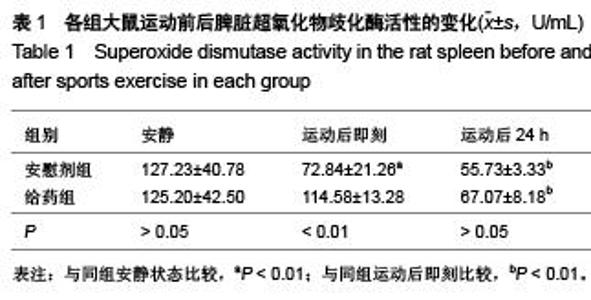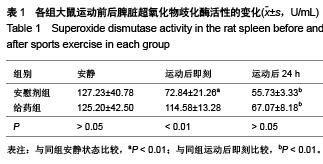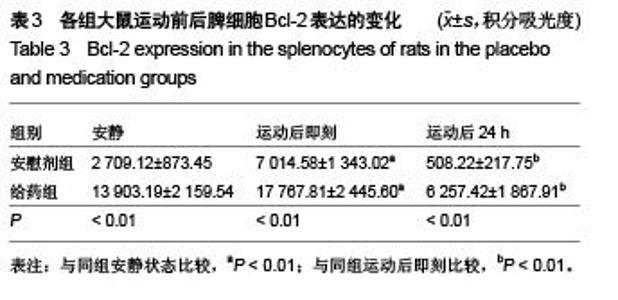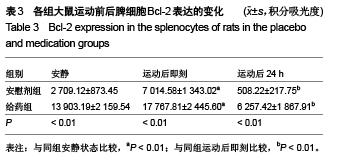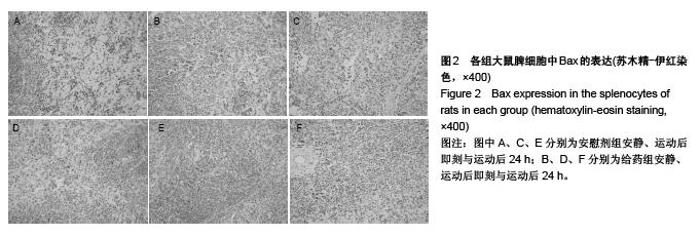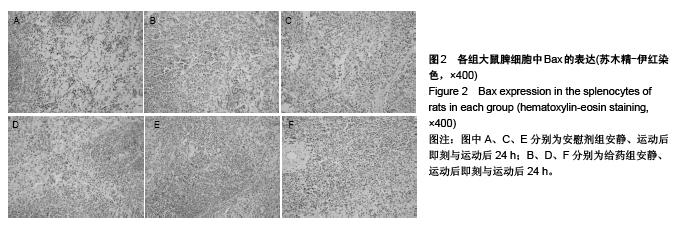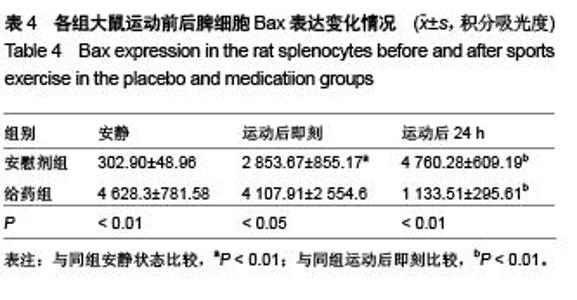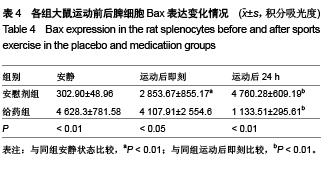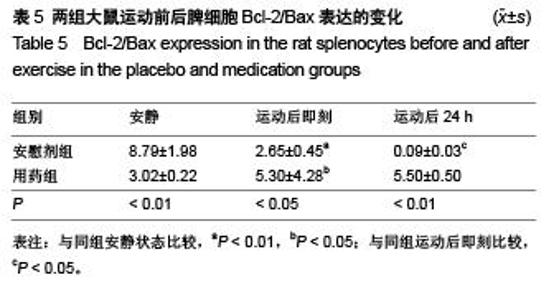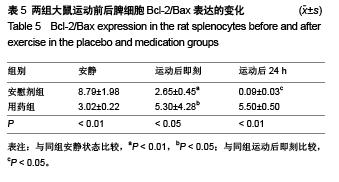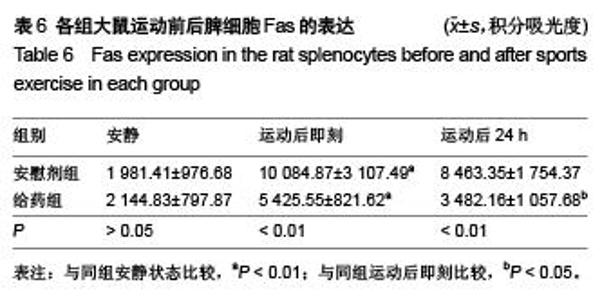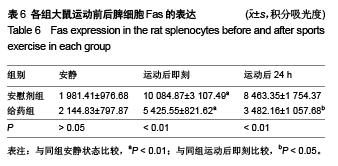Chinese Journal of Tissue Engineering Research ›› 2015, Vol. 19 ›› Issue (49): 8026-8031.doi: 10.3969/j.issn.2095-4344.2015.49.027
Previous Articles Next Articles
Effects of proanthocyanidins on free radical metabolism and apoptosis-related protein expression in rat splenocytes after heavy-load exercise
Li Yuan1, Liu Wen-jie2, Yang Ning1, Min Zhu1
- 1Sport Science College of Nanjing Normal University, Nanjing 210000, Jiangsu Province, China; 2Graduate School of Chengdu Sport University, Chengdu 610041, Sichuan Province, China
-
Online:2015-11-30Published:2015-11-30 -
About author:Li Yuan, Studying for master’s degree, Sport Science College of Nanjing Normal University, Nanjing 210000, Jiangsu Province, China
CLC Number:
Cite this article
Li Yuan, Liu Wen-jie, Yang Ning, Min Zhu. Effects of proanthocyanidins on free radical metabolism and apoptosis-related protein expression in rat splenocytes after heavy-load exercise[J]. Chinese Journal of Tissue Engineering Research, 2015, 19(49): 8026-8031.
share this article
| [1] Fitzgerald L.Exercise and the immune system.Immund Today. 1998;(19):337-339.[2] Gruzdera ON,Chikhman UN.The structure of the white pulp of the spleen and the peripheral blood indices in rats under increased muscle activity. Mortologia.1999; 116(7):658.[3] 李蕾,钟进义.葡多酚对凋亡和线粒体膜电位的影响[J].卫生研究, 2004,33(2):191-194[4] 刘玉娟,钟进义.葡多酚对辐射后淋巴细胞凋亡的影响[J].齐鲁医学杂志,2003,18(4):373-374.[5] Kimura Y,Ito H,Kawaji M,et al.Characterization and antioxidative properties of oligomeric proanthocyanidin from prunes, dried fruit of Prunus domestica L.Biosci Biotechnol Biochem.2008;72(6):1615-1618.[6] McCord JM,Fridovich I. The reduction of cytochrome c by milk xanthine oxidase.J Biol Chem.1968;243:5753-5760.[7] 曾明.松针提取液对运动小鼠自由基和糖代谢的影响[D].甘肃:西北师范大学,2004.[8] 郭英,蔡秀成,陈秋丽,等.葡萄籽提取物的体外抗脂质过氧化作用[J].卫生研究,2002,31(1):28-30.[9] 丰佃娟,徐贵发.葡萄籽提取物对人体抗氧化能力的影响[J].山东大学学报:医学版,2007,45(10):985-987.[10] 秦美芹,张国庆,秦总林.葡萄籽提取物对跆拳道运动员大负荷运动后CK、MDA、SOD、GSH-PX的影响[J].山东体育学院学报, 2006,22(5):72-74.[11] Adams JM,Cory S. The Bcl-2 protein family: Arbiters of cell survival.Science.1998; 281(5381):1322-1326.[12] Green DR,Reed JC.Mitochondria and apoptosis. Science. 1998;281(5381):1309-1132.[13] Gross A,Jockel J,Wei MC,et al.Enforced dimerizationof BAX results in its translocation, mitochondrial dysfunc-tion and apoptosis.EMBO J.1998;17(14):3878-3885.[14] Wei MC,Zong WX,Cheng EH,et al.Proapoptotic BAk and BAX:a requisite gate way to mitochondrial dysfunction and death.Science.2001;292(5517):727-730.[15] 闵柱,苏全生.原花青素干预大负荷运动大鼠腓肠肌相关凋亡蛋白的表达[J].中国组织与临床康复,2013,17(2):309-314.[16] 朱炬,王纪佐.大鼠局灶性脑缺血再灌注后Bcl-2和Bax的表达[J].天津医科大学学报,2003,9(1):42-44[17] 王旭光.原花青素对佐剂关节炎大鼠滑膜细胞Bcl-2、Bax表达的影响[J]中国药科大学学报,2007,38(4):365-368.[18] Martin A,Herr I,Jeremias I,et al.CD95 ligand (Fas-L/APO-1L) and TNF-related apoptosis-inducing ligand midiate is-chemia- induced apoptosis in neurons.J Neurosci. 1999;19:3809-3817.[19] Wan N,Yeo TT,Tang WY,et al.Apoptosis occurs after cerebralcontusions in humans. Neurosurgery. 2000;46(4): 949-956.[20] 庄永敬,徐小平.大鼠肝缺血再灌注后Fas及FasL蛋白表达变化及缺血预处理的保护机制[J].南方医科大学学报, 2006,26(10): 1518-1519. |
| [1] | Chen Ziyang, Pu Rui, Deng Shuang, Yuan Lingyan. Regulatory effect of exosomes on exercise-mediated insulin resistance diseases [J]. Chinese Journal of Tissue Engineering Research, 2021, 25(25): 4089-4094. |
| [2] | Chen Yang, Huang Denggao, Gao Yuanhui, Wang Shunlan, Cao Hui, Zheng Linlin, He Haowei, Luo Siqin, Xiao Jingchuan, Zhang Yingai, Zhang Shufang. Low-intensity pulsed ultrasound promotes the proliferation and adhesion of human adipose-derived mesenchymal stem cells [J]. Chinese Journal of Tissue Engineering Research, 2021, 25(25): 3949-3955. |
| [3] | Yang Junhui, Luo Jinli, Yuan Xiaoping. Effects of human growth hormone on proliferation and osteogenic differentiation of human periodontal ligament stem cells [J]. Chinese Journal of Tissue Engineering Research, 2021, 25(25): 3956-3961. |
| [4] | Sun Jianwei, Yang Xinming, Zhang Ying. Effect of montelukast combined with bone marrow mesenchymal stem cell transplantation on spinal cord injury in rat models [J]. Chinese Journal of Tissue Engineering Research, 2021, 25(25): 3962-3969. |
| [5] | Gao Shan, Huang Dongjing, Hong Haiman, Jia Jingqiao, Meng Fei. Comparison on the curative effect of human placenta-derived mesenchymal stem cells and induced islet-like cells in gestational diabetes mellitus rats [J]. Chinese Journal of Tissue Engineering Research, 2021, 25(25): 3981-3987. |
| [6] | Hao Xiaona, Zhang Yingjie, Li Yuyun, Xu Tao. Bone marrow mesenchymal stem cells overexpressing prolyl oligopeptidase on the repair of liver fibrosis in rat models [J]. Chinese Journal of Tissue Engineering Research, 2021, 25(25): 3988-3993. |
| [7] | Liu Jianyou, Jia Zhongwei, Niu Jiawei, Cao Xinjie, Zhang Dong, Wei Jie. A new method for measuring the anteversion angle of the femoral neck by constructing the three-dimensional digital model of the femur [J]. Chinese Journal of Tissue Engineering Research, 2021, 25(24): 3779-3783. |
| [8] | Meng Lingjie, Qian Hui, Sheng Xiaolei, Lu Jianfeng, Huang Jianping, Qi Liangang, Liu Zongbao. Application of three-dimensional printing technology combined with bone cement in minimally invasive treatment of the collapsed Sanders III type of calcaneal fractures [J]. Chinese Journal of Tissue Engineering Research, 2021, 25(24): 3784-3789. |
| [9] | Qian Xuankun, Huang Hefei, Wu Chengcong, Liu Keting, Ou Hua, Zhang Jinpeng, Ren Jing, Wan Jianshan. Computer-assisted navigation combined with minimally invasive transforaminal lumbar interbody fusion for lumbar spondylolisthesis [J]. Chinese Journal of Tissue Engineering Research, 2021, 25(24): 3790-3795. |
| [10] | Hu Jing, Xiang Yang, Ye Chuan, Han Ziji. Three-dimensional printing assisted screw placement and freehand pedicle screw fixation in the treatment of thoracolumbar fractures: 1-year follow-up [J]. Chinese Journal of Tissue Engineering Research, 2021, 25(24): 3804-3809. |
| [11] | Shu Qihang, Liao Yijia, Xue Jingbo, Yan Yiguo, Wang Cheng. Three-dimensional finite element analysis of a new three-dimensional printed porous fusion cage for cervical vertebra [J]. Chinese Journal of Tissue Engineering Research, 2021, 25(24): 3810-3815. |
| [12] | Wang Yihan, Li Yang, Zhang Ling, Zhang Rui, Xu Ruida, Han Xiaofeng, Cheng Guangqi, Wang Weil. Application of three-dimensional visualization technology for digital orthopedics in the reduction and fixation of intertrochanteric fracture [J]. Chinese Journal of Tissue Engineering Research, 2021, 25(24): 3816-3820. |
| [13] | Sun Maji, Wang Qiuan, Zhang Xingchen, Guo Chong, Yuan Feng, Guo Kaijin. Development and biomechanical analysis of a new anterior cervical pedicle screw fixation system [J]. Chinese Journal of Tissue Engineering Research, 2021, 25(24): 3821-3825. |
| [14] | Lin Wang, Wang Yingying, Guo Weizhong, Yuan Cuihua, Xu Shenggui, Zhang Shenshen, Lin Chengshou. Adopting expanded lateral approach to enhance the mechanical stability and knee function for treating posterolateral column fracture of tibial plateau [J]. Chinese Journal of Tissue Engineering Research, 2021, 25(24): 3826-3827. |
| [15] | Zhu Yun, Chen Yu, Qiu Hao, Liu Dun, Jin Guorong, Chen Shimou, Weng Zheng. Finite element analysis for treatment of osteoporotic femoral fracture with far cortical locking screw [J]. Chinese Journal of Tissue Engineering Research, 2021, 25(24): 3832-3837. |
| Viewed | ||||||
|
Full text |
|
|||||
|
Abstract |
|
|||||
